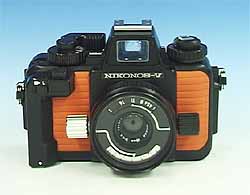 Mixed Plate Mixed Plate
Nikonos V Tips

My Nikonos V
The Nikonos series of cameras are made by Nikon and were originally
designed for underwater (UW) scuba-type photography. Here's a little
review on the goods and bads of my Nikonos V camera, as it pertains to surf
photography.
I got my Nikonos V from a Navy exchange way back around 1991. The
body and 35 mm lens cost me $515. The price has since gone up to over
$800!
First time shooting, I got something like 20 out of 25 decent shots. I
was amazed and stoked at the high percentage of "keepers".
Little did I know that this good success rate was the exception and not the
rule.
On that first roll, I was shooting in good lighting, shallow water and small
waves, so I could get pretty intimate with the surfers. In the real
world of bigger surf, however, I had to step back from the subject and my
photos showed with tiny riders on wide-open views.
It comes with a hand strap that I still use today, girth-hitching it to my
right wrist. Thought about putting a leash on, but I never really
needed one.
So the controls (focus and aperture) are made to be preset and aren't
easy at all to adjust on the fly.
Viewfinder
Although the viewfinder has through-the-lens (ttl) exposure metering, the
picture frame is *not* WYSIWYG. There's a separate viewfinder for
framing pictures. When you shoot close shots, you have to actually
compensate for the lens and viewfinder disparity by tilting the camera a tad
higher.
The V has quite a bit of automation, with a program mode that can adjust the
shutter speed to match the available light (aperture priority). I've
found this automated exposure kind of spotty, and actually set both the
aperture and shutter manually.
One time, I must've knocked the camera around too much, because the
reflecting mirror in the viewfinder got knocked out of place. I've
since banged the camera around enough so that it is out of the way, but now
I can't see the LED shutter settings in auto mode. That's the main
reason I
manually set the camera up.
Trigger
There's a trigger lock that doesn't allow you to waste film during the
paddle outs. Problem is that I've lost more than a few epic shots
because I stupidly had this engaged. Use with caution.
The trigger itself very mechanical and not very positive. It's hard to
distinguish exactly when the shutter is engaged. This evokes the
tendency to click it quickly, but doing so too fast might cause jitter,
which equates to blur.
Changing lenses is a snap--just twist and release. Putting the lens on
feels very sketchy--it doesn't seem like the seal is good enough to be
watertight. But amazingly, it is.
Settings
As far as settings, I just kind of eyeball the lighting and set the camera
accordingly. I try to make sure I get at least 1/250 speed, then
minimize the aperture size (bigger numbers) to get maximum depth of field.
I preset the focus, anticipating how far the subject will be when I shoot.
Typically
this is about 15+ feet. Think I base my settings accordingly in bright
sunlight: ASA 100, F8, 1/500.
The lens has a neat configuration where it shows the focal range for any
given aperture setting. Helps in framing and waiting for the right
moment. Fairly accurate, I believe.
The camera truly is built like a tank, with a body made of metal. The
waterproof seals are established using two O-rings--one to get to the film
area and one for the battery compartment. Nikon recommends cleaning
this area regularly, and applying their O-ring grease. Knock on wood
but I haven't had a major catastrophe yet, even though some sand has slipped
into the seal area.
Been looking for that 80 mm lens used (I even mentioned this to George
Barnes and Tom Keener on my recent trip to San Diego). Don't know how
it works--at over $500 brand new I'm not financially
ready to give it a shot.
Film
As for film, well that's a whole story in itself. For slides, I prefer
Fuji Sensia because you can get it with ASA 400. The Provias and
Velvias are too expensive and I can't handle the slow speed and short
expiration period.
For print film, I used to use exclusively Fuji because of the nice blues and
greens exposure. However, I've recently tried the Kodak Max films and
love the quality.
The details are great, but the proof is in the pudding.
http://www.iav.com/~sponge/sesh/sesh66.htm
http://www.iav.com/~sponge/sesh/new/sesh159.htm
http://www.iav.com/~sponge/sesh/new2/sesh261.htm
sponge


|
